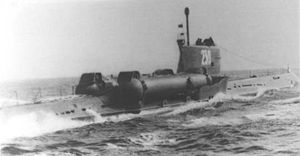- P-5 Pyatyorka
-
 Whiskey Twin Cylinder submarine armed with P-5 missiles.
Whiskey Twin Cylinder submarine armed with P-5 missiles.
The P-5 "Pyatyorka" (Russian: П-5 «Пятёрка»; "Pyatyorka" means "fiver" in English - the equivalent to an A grade) was a Cold War era turbojet-powered cruise missile of the Soviet Union, designed by the Chelomey design bureau. The missile entered service in 1959. Pyatyorka is a common name for the missile as the "digit 5", corresponding to the R-7 Semyorka, the digit 7.
The basic version of the missile was a inertially-guided submarine-launched cruise missile to threaten the US coast. The missile could be armed with either a 1000 kg high explosive or a 200 or 350 kt nuclear warhead. It had a speed of about 0.9 Mach, range of 500 km and CEP of about 3000 m. The later variant had a range of possibly up to 1000 km. The first missiles were installed in Project 644, Whiskey Twin Cylinder and Project 665, Whiskey Long Bin submarines.
Versions of P-5 were later developed equipped with radar homing to be used as anti-ship missiles. The last anti-ship versions were retired from active service about 1990, replaced by the P-500 Bazalt and P-700 Granit.
There were actually three versions of turbojet-powered, cruise missiles that were called "SS-N-3" by Western intelligence sources, with multiple variants. The earliest, P-5 was called SS-N-3c, and later versions SS-N-3a and SS-N-3b. The various Russian designations are believed to be P-5 "Pyatyorka", P-6, P-7, and P-35 Progress. Some sources indicate that missiles 'P-10' and 'P-25' may also exist.
NATO called the submarine-launched radar-homing versions of the P-6 SS-N-3A 'Shaddock'. These were carried by Echo II and Juliett class submarines for targeting US aircraft carriers. Russian sources indicate that there was only submarine-launched version of P-5. The surface-launched, radar-homing version called P-35 was used by Kynda and Kresta I class guided-missile cruisers. The P-7 was possibly a longer-ranged version of the P-5, or a further development of the P-6.
There were also land-based versions of these missiles transported in and launched from an eight-wheel truck.
Yugoslavia deployed the SS-N-3 as a ground-sea system.
Contents
Operators
Specifications
- Length: 10.20 m (a/b) or 11.75 m (model C)
- Diameter: 0.98m
- Wingspan: 5 m
- Weight: 5000 kg
- Propulsion: turbojet with launch rocket boosters
- Speed up to Mach 0.9
- Range: 450 km (a/b), 750 km (model C)
- Guidance Inertial with mid course correction via data link. Terminal active radar in conventional-armed versions.
- Warhead: 1000kg conventional or 200-350 kt nuclear
Deployment
This missile was deployed on the following ships;
- Whiskey Twin Cylinder submarines (early unguided versions)
- Whiskey Long Bin submarines (early unguided versions)
- Juliett class submarines
- Echo class submarines
- Kynda class cruisers
- Kresta I class cruisers
The Lake Inari Incident
On 28 December 1984 a SS-N-3 missile used as a target by the Soviet Navy strayed over Finnish border and crashed into Lake Inari.[2][3]
References
- ^ Bulgaria - Naval Forces
- ^ Scandinavia Wayward Missile - TIME
- ^ Finns Return Soviet Missile That Strayed in Maneuvers - NYTimes.com
- http://www.globalsecurity.org/military/world/russia/ss-n-3-specs.htm
- http://www.fas.org/nuke/guide/russia/theater/ss-n-3.htm
- http://www.janes.com/articles/Janes-Strategic-Weapon-Systems/P-6710-and-P-535-SS-N3-Shaddock-and-SSC-1-Sepal-Russian-Federation.html
- http://warships.ru/Russia/Weapons/PKR/P-35/index2.html
External links
- MARITIME STRIKE The Soviet Perspective
- SSC-1a Shaddock and SS-N-3 Sepal at Federation of American Scientists
Categories:- Anti-ship cruise missiles of the Soviet Union
- Nuclear cruise missiles of the Soviet Union
- Cold War cruise missiles
- Cold War nuclear missiles
Wikimedia Foundation. 2010.
